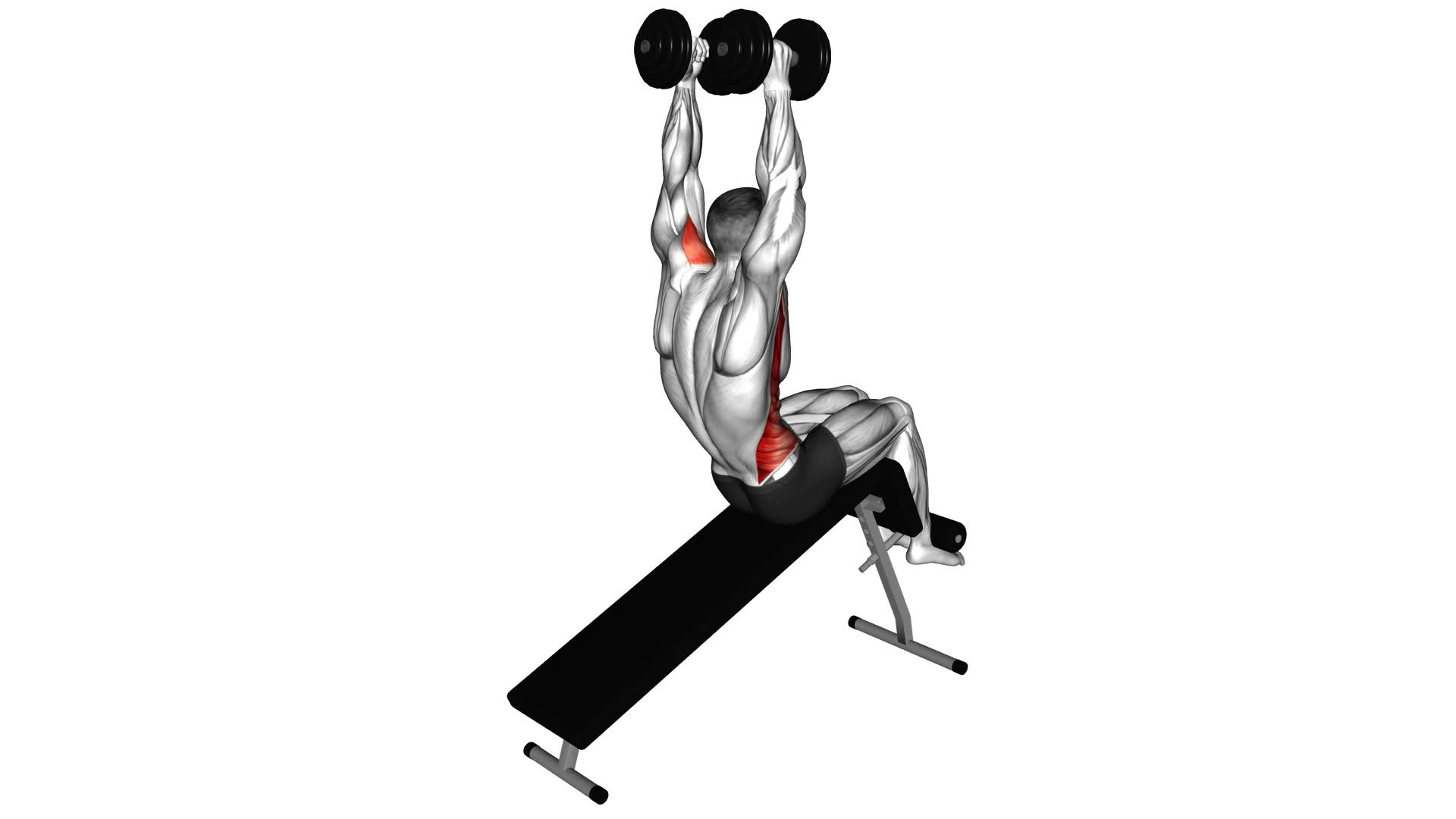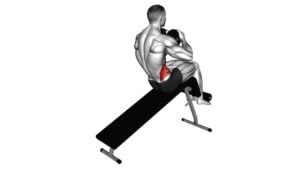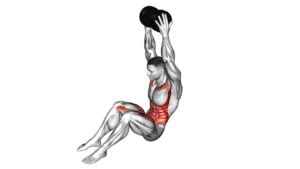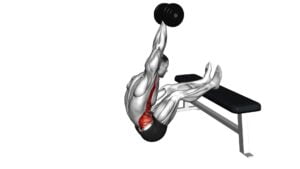Dumbbell Decline Overhead Sit-up – Video Exercise Guide & Tips

Are you looking for a challenging core exercise that targets your abs and shoulders? Look no further than the dumbbell decline overhead sit-up!
Watch This Exercise Video
This exercise not only strengthens your core muscles but also engages your upper body.
In this article, we will guide you through proper form, modifications for all fitness levels, and common mistakes to avoid.
Get ready to take your core training to the next level with this effective exercise.
Key Takeaways
- The Dumbbell Decline Overhead Sit-up increases core strength and improves abdominal muscle definition.
- It targets abs, obliques, and hip flexors while engaging upper body muscles.
- Proper form and technique include maintaining a neutral spine, engaging core muscles, and avoiding common mistakes such as using excessive weight or using neck and shoulders.
- Modifications and progressions can be made for all fitness levels by adjusting the weight of the dumbbell, starting with lighter weights for beginners, and using variations like a flat bench or stability ball.
Benefits of the Dumbbell Decline Overhead Sit-up
You will experience increased core strength and improved abdominal muscle definition with the Dumbbell Decline Overhead Sit-up. This exercise targets your abs, obliques, and hip flexors, making it an effective way to strengthen your core. By adding dumbbells to the exercise, you increase the resistance and challenge your muscles even more.
The Dumbbell Decline Overhead Sit-up is a variation of the traditional decline sit-up that specifically targets your core muscles. It involves lying on a decline bench with your feet secured, holding a dumbbell with both hands above your head. As you perform the sit-up, you engage your core to lift your upper body off the bench while keeping the dumbbell overhead. This movement not only works your abdominals but also engages your shoulders and upper back.
Incorporating dumbbell decline sit-up variations into your core strengthening exercises can help you develop a stronger and more defined midsection. These exercises challenge your core muscles in different ways, allowing for greater muscle activation and growth. By regularly incorporating the Dumbbell Decline Overhead Sit-up into your workout routine, you can achieve increased core strength and improved abdominal muscle definition.
Equipment Needed for the Exercise
To perform the dumbbell decline overhead sit-up, you'll need a few essential pieces of equipment.
First, you'll need a decline bench to provide the necessary incline for the exercise.
Additionally, you'll need a pair of dumbbells to hold overhead while performing the sit-up.
If you don't have access to a decline bench, you can modify the exercise by using an adjustable incline bench or even a stable elevated surface like a step or platform.
Essential Equipment for Exercise
To properly perform the Dumbbell Decline Overhead Sit-up, it's essential to have the right equipment. Here are the three essential pieces of exercise gear you'll need:
- Dumbbells: Choose a pair of dumbbells that are appropriate for your fitness level. The weight should challenge you but still allow you to maintain proper form throughout the exercise.
- Decline Bench: This specialized bench is designed to be adjustable, allowing you to decline the angle as needed. It provides stability and support for your back during the sit-up, ensuring proper alignment and reducing the risk of injury.
- Exercise Mat: Place an exercise mat on the bench to add comfort and prevent slipping. It also helps to protect your back and shoulders from unnecessary strain.
Having the right equipment is crucial for performing the Dumbbell Decline Overhead Sit-up safely and effectively. Make sure to invest in these essential items before attempting this exercise.
Alternatives for Equipment
Consider alternative options for the necessary equipment when performing the Dumbbell Decline Overhead Sit-up.
If you don't have access to dumbbells or a decline bench, there are still ways to work your core effectively with bodyweight exercises. One option is to perform regular sit-ups without any added weight. Lie on your back, bend your knees, and place your hands behind your head. Lift your upper body off the ground by contracting your abs and then lower back down slowly.
Another alternative is to try decline sit-ups without the dumbbells. Find a sturdy surface, like a step or a low bench, and position it at an angle. Lie down with your head lower than your feet and perform the sit-up motion, engaging your core muscles.
These alternatives are perfect for home workouts without any equipment.
Proper Form and Technique for the Exercise
To perform the dumbbell decline overhead sit-up exercise with proper form and technique, start by lying on a decline bench with a dumbbell held securely overhead.
Here are some tips to ensure you maintain proper form and prevent injuries:
- Maintain a neutral spine: Keep your back straight and avoid arching or rounding it during the movement. This will help protect your lower back and prevent strain.
- Engage your core: Before you begin the sit-up, engage your abdominal muscles by pulling your belly button towards your spine. This will provide stability and support throughout the exercise.
- Control the movement: Slowly lower your upper body towards the bench, keeping your core engaged. As you come up, exhale and use your abs to lift your torso back to the starting position. Avoid using momentum or jerking motions.
Common mistakes to avoid include:
- Using your neck and shoulders to pull yourself up, rather than relying on your core muscles.
- Allowing the dumbbell to drift too far forward, which can strain your shoulders and neck.
- Using excessive weight that compromises your form and puts unnecessary stress on your lower back.
Modifications and Progressions for All Fitness Levels
For all fitness levels, a modification that can be made to the dumbbell decline overhead sit-up is adjusting the weight used. This exercise can be adapted to suit different strength levels by increasing or decreasing the weight of the dumbbell. If you're a beginner or have limited core strength, you may want to start with a lighter weight or even no weight at all. As you become more comfortable and stronger, you can gradually increase the weight to challenge your muscles further. On the other hand, if you find the exercise too difficult or are unable to maintain proper form with a heavier weight, it's important to decrease the weight to prevent injury and ensure proper technique.
In addition to adjusting the weight, there are other variations and progressions that can be incorporated into the dumbbell decline overhead sit-up to cater to different fitness levels. Some examples include performing the exercise on a flat bench instead of a decline bench, using a stability ball instead of a bench, or even adding a twist at the top of the movement to engage the obliques. These adaptations can help add variety to your workout routine and target different muscle groups.
Common Mistakes to Avoid
When performing the dumbbell decline overhead sit-up, it's important to be mindful of your form to avoid common mistakes. Proper form correction tips can help you engage the correct muscles and maximize the effectiveness of the exercise.
Additionally, injury prevention techniques such as using a spotter or starting with lighter weights can help protect your body during the movement.
Lastly, mastering proper breathing techniques can enhance your performance and prevent strain on your muscles.
Form Correction Tips
If you want to improve your form and avoid common mistakes while performing the dumbbell decline overhead sit-up, focus on maintaining proper alignment and engaging your core throughout the exercise. Here are some form correction tips to help you perform the exercise safely and effectively:
- Keep your spine neutral: Avoid arching or rounding your back during the movement. Maintain a straight spine to prevent strain or injury.
- Engage your core: Throughout the exercise, focus on contracting your abdominal muscles. This won't only help you maintain stability but also enhance the effectiveness of the sit-up.
- Control your descent: Avoid dropping your torso down quickly. Instead, lower yourself slowly and with control to ensure proper engagement of your core muscles.
Injury Prevention Techniques
To prevent injuries and maximize your results, focus on avoiding common mistakes while performing the dumbbell decline overhead sit-up.
Injury prevention techniques and strategies are crucial to ensure a safe and effective workout. First, make sure to maintain proper form throughout the exercise. Keep your back straight, engage your core, and avoid arching or rounding your spine.
Additionally, use an appropriate weight for your fitness level to avoid straining your muscles. It's also important to warm up before starting the exercise to prepare your body and reduce the risk of injury.
Lastly, listen to your body and take breaks when needed. Pushing yourself too hard can lead to overexertion and potential injuries.
Proper Breathing Techniques
To ensure a safe and effective dumbbell decline overhead sit-up, it's important to master proper breathing techniques and avoid common mistakes. Proper breathing during this exercise helps engage your core muscles and maximize your performance. Here are three key breathing exercises to incorporate into your routine:
- Diaphragmatic breathing: Focus on breathing deeply into your diaphragm instead of shallow chest breathing. This helps fully oxygenate your muscles and stabilize your core.
- Exhale on exertion: As you lift your torso during the sit-up, exhale forcefully through your mouth. This helps activate your abdominal muscles and provides stability.
- Avoid holding your breath: Holding your breath can increase intra-abdominal pressure and put unnecessary strain on your body. Remember to breathe continuously throughout the movement.
By mastering these breathing techniques, you can enhance the effectiveness of your dumbbell decline overhead sit-up and reduce the risk of injury.
Now, let's move on to some tips for maximizing the effectiveness of the exercise.
Tips for Maximizing the Effectiveness of the Exercise
To maximize the effectiveness of the exercise, focus on maintaining proper form and engaging your core throughout the movement. This will ensure that you're targeting the right muscles and getting the most out of each repetition.
One tip for maximizing results is to start with a lighter weight and gradually increase the resistance as you get stronger. This will help you avoid straining your muscles and allow you to progress at a safe and steady pace.
Another variation for beginners is to perform the exercise without using dumbbells, using just your body weight instead. This will help you build up your strength and stability before adding additional resistance.
Additionally, it's important to keep your back flat against the decline bench and avoid rounding your shoulders or arching your lower back. This will help maintain proper spinal alignment and prevent any unnecessary strain.
Lastly, make sure to breathe deeply and exhale as you crunch up, engaging your core muscles even more.
Frequently Asked Questions
How Many Sets and Reps Should I Do of the Dumbbell Decline Overhead Sit-Up?
To determine the number of sets and reps for the dumbbell decline overhead sit-up, consider your fitness level and goals. Start with 2-3 sets of 10-12 reps and adjust as needed.
This exercise engages your core muscles, especially the rectus abdominis. It also targets the hip flexors and shoulders.
The decline position adds an extra challenge by increasing the range of motion. Remember to maintain proper form and use a weight that challenges you without compromising technique.
Can I Do This Exercise if I Have Lower Back Problems?
If you have lower back problems, there are modifications you can make to the dumbbell decline overhead sit-up. You can try using lighter weights or even just your body weight to decrease the strain on your lower back.
Another alternative exercise you can do is the decline crunch, which targets your abdominal muscles without putting as much pressure on your lower back.
Always listen to your body and consult with a healthcare professional before trying any new exercises.
Is It Necessary to Use a Decline Bench for This Exercise or Can I Use a Regular Bench?
If you're wondering whether it's necessary to use a decline bench for the dumbbell decline overhead sit-up, the short answer is no.
While using a decline bench can provide some extra benefits, such as increased activation of your core muscles, you can still perform this exercise effectively on a regular bench.
Just make sure to maintain proper form and focus on engaging your abs throughout the movement.
Can I Use a Kettlebell Instead of a Dumbbell for This Exercise?
Yes, you can definitely use a kettlebell instead of a dumbbell for this exercise. It's a great alternative equipment option that will still give you the same benefits.
The kettlebell substitution will allow you to work your core muscles and upper body effectively. Just make sure to choose a kettlebell that's appropriate for your strength level and use proper form throughout the exercise.
Should I Do This Exercise Before or After My Cardio Workout?
Before or after cardio, the dumbbell decline overhead sit-up can be a great addition to your workout routine. This exercise targets your core muscles, helping to improve strength and stability. Incorporating it into your routine before cardio can help activate your core and prepare your body for the workout ahead.
On the other hand, doing it after cardio can provide an additional challenge and help further fatigue your core muscles. Ultimately, the choice depends on your personal preference and fitness goals.
Conclusion
In conclusion, the dumbbell decline overhead sit-up is a beneficial exercise that targets the core muscles while also engaging the shoulders and arms.
It requires minimal equipment and can be modified to suit different fitness levels.
By following proper form and avoiding common mistakes, you can maximize the effectiveness of this exercise.
Incorporate it into your workout routine to strengthen and tone your abs and improve overall core stability.

Author
Years ago, the spark of my life’s passion ignited in my mind the moment I stepped into the local gym for the first time. The inaugural bead of perspiration, the initial endeavor, the very first surge of endorphins, and a sense of pride that washed over me post-workout marked the beginning of my deep-seated interest in strength sports, fitness, and sports nutrition. This very curiosity blossomed rapidly into a profound fascination, propelling me to earn a Master’s degree in Physical Education from the Academy of Physical Education in Krakow, followed by a Sports Manager diploma from the Jagiellonian University. My journey of growth led me to gain more specialized qualifications, such as being a certified personal trainer with a focus on sports dietetics, a lifeguard, and an instructor for wellness and corrective gymnastics. Theoretical knowledge paired seamlessly with practical experience, reinforcing my belief that the transformation of individuals under my guidance was also a reflection of my personal growth. This belief holds true even today. Each day, I strive to push the boundaries and explore new realms. These realms gently elevate me to greater heights. The unique combination of passion for my field and the continuous quest for growth fuels my drive to break new ground.







